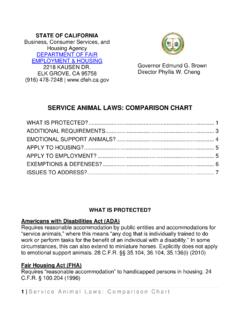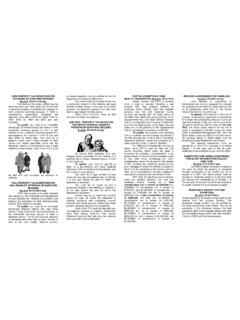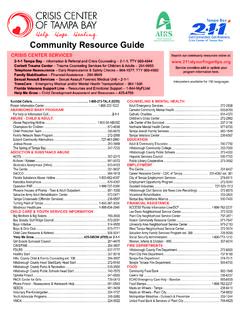Transcription of Sizing Plumbing Water System - PDHonline.com
1 PDHonline Course M126 (3 PDH) Sizing Plumbing Water System2012 Instructor: A. Bhatia, Online | PDH Center5272 Meadow Estates DriveFairfax, VA 22030-6658 Phone & Fax: Approved Continuing Education PDH Course M126 Sizing Plumbing Water Systems A. Bhatia, Course Content PART I - ESTIMATING Water DEMANDS A fundamental consideration in the Sizing of a Plumbing Water System or its components is an estimate of the amount of Water expected to be used by the customers.
2 Estimating demand depends on the Water usage patterns and is usually unique for a particular System . For instance, a difference can exist for a residential and a non-residential System . A Water usage pattern may also be unique because of the individuality of consumers on the System and their expectations to use Water whenever and however they wish. Water demand estimation is complex and involves consideration of a number of factors: 1. Climatic influences (evaporation, vapor transpiration, temperature, precipitation, winds, etc.)
3 ; Climate has a significant impact on Water use. For instance, in areas where freezing temperatures are prevalent, Water use should be closely evaluated. Some systems may see higher demands as users allow faucets to run to prevent freezing. 2. Socioeconomic influences (property values, economic status, residential densities); Demographics change with the nature of a development. Population densities are different for single family and multi-family residences; for housing provided for families and housing provided for singles or senior citizens /retirees; and for individual lots and mobile home park type developments.
4 3. Property lots; housing sizes are usually directly linked to the income levels of the residents. Middle-income residents typically occupy 1,500 to 3,000 square foot homes with moderate sized lawns. Higher income residents occupy homes larger than 3,000 square feet. With respect to Water use, the greatest impact of income level is probably the extent of landscaping. The major factor in Water use related to larger lot sizes is in the irrigable area, such as lawns, gardens, and other agricultural uses. A. Bhatia Page 2 of 35 4.
5 Recreational or seasonal uses; Water use and demand at public places, such as amusement parks, vary and can be different. Recreational areas usually experience peak demands during summer holiday weekends such as Memorial Day, Independence Day, and Labor Day. PDH Course M126 5. Extent of metering or pricing schedules; Water pricing structure may vary place to place. Some systems may use a Water meter that tends to price on actual use; others may have flat rates fixed on property size.
6 6. Historic Water log sheets; Places like airports, hotels, hospitals and public buildings see more or less consistent overall demand. The only design variable involved for the facility is the volume of traffic. 7. Land use; The purpose of a facility should be assessed. Commercial, industrial and public facility demands are much different from residential demand. Water use associated with the services of cleaning, landscaping, and farming need to be assessed carefully. 8. Conservation practices; Areas that have acute or scarce Water resources resort to mandatory conservation measures.
7 Mandatory conservation practices include, but are not limited to, alternate day watering schedules, installation of low Water use fixtures, Water closet tank displacement devices, leak detection, rainwater harvesting, and use of treated effluent Water for landscaping. Unaccounted Water demand reduction programs also exist. Community covenants, bylaws or local ordinances may exist to support Water conservation practices. It is very important to determine if Water use restrictions are enforceable. Why Plumbing Codes?
8 It is nearly impossible to predict the consumer mind-set or socioeconomic ethics on Water use. There is usually insufficient data to account for all the factors that may influence the Water demands of a particular Water System . Defined design criteria are laid out in the ASHRAE guide and the Uniform Plumbing Code (UPC). Both criteria focus on the use of probability theory with a safety factor to compensate for unknown variables. Required flow rates are defined based on a Fixture Count method that is determined after appropriate research and analysis of controlling variables.
9 Among a host of other factors, these variables are fixture types, people use factors for structure types, and people socioeconomic factors. There is no substitute for reliable and accurate meter records of Water usage for estimating future demand. An historic data approach allows a designer to use metered Water use data from an existing facility to estimate the demand of a new System . Model Plumbing Codes A. Bhatia Page 3 of 35 The model universal Plumbing codes list minimum requirements for potable Water systems based on probability theory.
10 PDH Course M126 The five model Plumbing code agencies in the United Sates are: 1. Uniform Plumbing Code (UPC); adopted mainly in the western 2. Standard Plumbing Code (SPC); adopted mainly in the southern 3. BOCA Plumbing Code (BOCA); adopted mainly in the eastern 4. International Plumbing Code (IPC). 5. CABO Plumbing Code (CABO); exclusively for residential construction. Salient features of these codes are: The IPC is relatively new code originating in 1995 as a joint effort of the three major model code groups (UPC, SPC and BOCA).


















